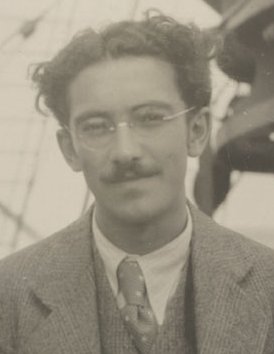Murray Adaskin facts for kids
Quick facts for kids
Murray Adaskin
|
|
|---|---|

Murray Adaskin in 1929
|
|
| Background information | |
| Born | March 28, 1906 Toronto, Ontario, Canada |
| Died | May 6, 2002 (aged 96) Victoria, British Columbia, Canada |
| Occupation(s) | composer |
Murray Adaskin (born March 28, 1906, died May 6, 2002) was a talented Canadian musician. He was a violinist, a composer who wrote music, a conductor who led orchestras, and a teacher. He was born in Toronto. After playing the violin in a band, he learned how to compose music. Later, he became the head of the Music department at the University of Saskatchewan. He wrote many of his musical pieces after he retired and moved to Victoria.
Contents
Life of a Musician and Teacher
Murray Adaskin was born in Toronto, Ontario. His parents were immigrants from Latvia. They encouraged their four children to work hard. Murray learned to play the violin at the Toronto Conservatory of Music. His teacher was Alexander Chuhaldin.
He started his music career playing the violin for silent movies. These were films without sound, so musicians played live music to go along with the story. From 1923 to 1936, he played violin with the Toronto Symphony Orchestra. He married his first wife, a singer named Frances James, around this time.
Becoming a Composer and Educator
When he was 38, Murray Adaskin began studying to become a composer. He studied for seven years with John Weinzweig. He also learned from other famous composers like Charles Jones and Darius Milhaud.
From 1952 to 1966, he was the head of the Music Department at the University of Saskatchewan. For four of those years, he also led the Saskatoon Symphony Orchestra as its conductor. After that, he became the first "Composer-in-Residence" at a Canadian university. This meant he was a composer who worked and taught at the university.
Many students learned from him. Some of his notable students became composers themselves, like Boyd McDonald and Paul Pedersen. A famous violinist named Andrew Dawes also studied with him.
Retirement and Later Years
In 1972, Murray Adaskin retired and moved to Victoria, British Columbia. This is where he wrote more than half of his 130 musical pieces.
His first wife, Frances, passed away in 1988. Later, he married Dorothea Larsen. She helped him record some of his music on their own record label. Murray Adaskin died in 2002. This was just before two CDs from a five-disc collection of his music were released to honor him. He had three brothers who were also musicians: Harry, Leslie, and John Adaskin.
On December 15, 1980, Murray Adaskin received a special award. He was given the Order of Canada. This is one of the highest honors a Canadian citizen can receive. On April 8, 1981, he was officially named an Officer of the Order of Canada.
Music Inspiration and Style
A famous composer named Igor Stravinsky greatly inspired Murray Adaskin. Stravinsky's music often had strong, clear rhythms. You can hear these kinds of rhythms in Adaskin's work too.
Because Murray Adaskin was a violinist, he had a strong sense of melody. Melody is the main tune of a piece of music. His music often makes you feel like you are hearing landscapes, birdsongs, and sounds from nature.
Connecting Art and Music
The melodies in his compositions sometimes felt abstract. This was similar to Canadian visual art from his early years. He was very interested in Canadian visual art. This interest showed up in his music, like in his piece called In Praise of Canadian Painting in the Thirties.
Selected Works
Here are some of the musical pieces Murray Adaskin composed:
- Epitaph for voice and piano (1948)
- March No.1 for orchestra (1950)
- Sonata for Piano (1950)
- Sonatine Baroque for violin solo (1952) or viola solo (1999)
- March No.2 for orchestra (1953, revised 1962)
- Rondino for Nine Instruments (1961)
- Dedication (1963)
- Daydreams for alto saxophone and piano (1971)
- Woodwind Quintet No.1 (1974)
- Rankin Inlet for piano duet (1978)
- Eskimo Melodies for piano (1980)
- March No.3 for orchestra (1981)
- Vocalise No.1 for solo viola (1990)
- Concerto No.1 for viola and orchestra (1991)
- Three Piano Pieces (Savannah, Gretchen, and Etude No. 1), for Piano (1992)
- Concerto No.2 for viola and orchestra (1995)
- String Quintet (1995)
- Duo for viola and guitar (1996)
- Vocalise No.2 for solo viola (1996)
- Divertimento No.9 for string trio (1998)
- Duo for viola and piano (1999)
- Finki, Where Are You? for 2 violas (2000)
- Musica Victoria (2000)
See also
- Music of Canada
- List of Canadian composers

